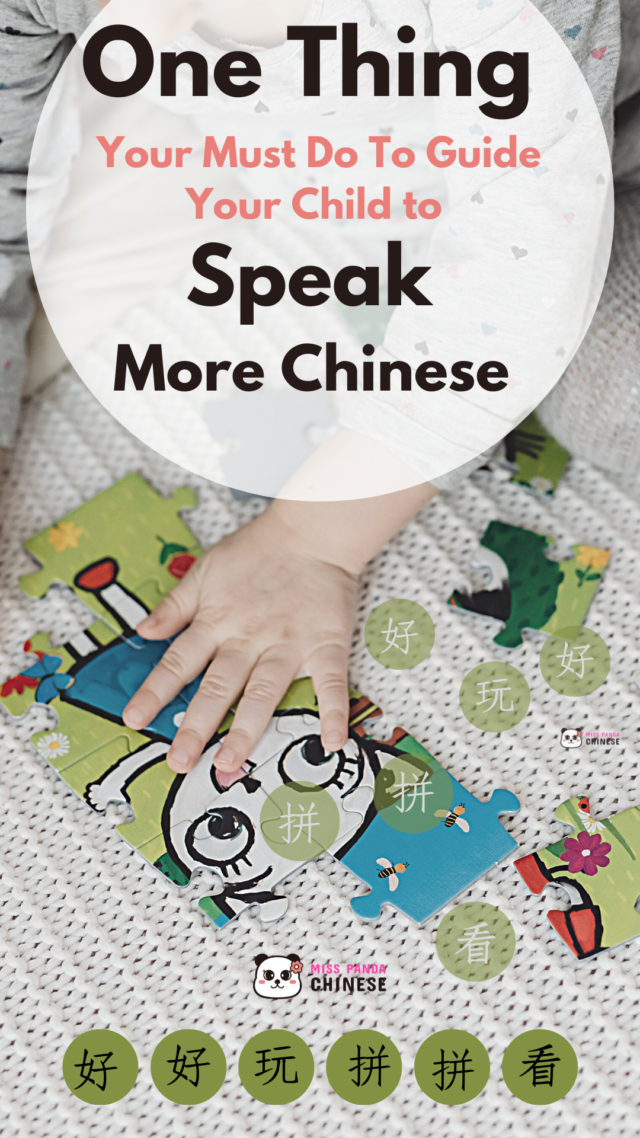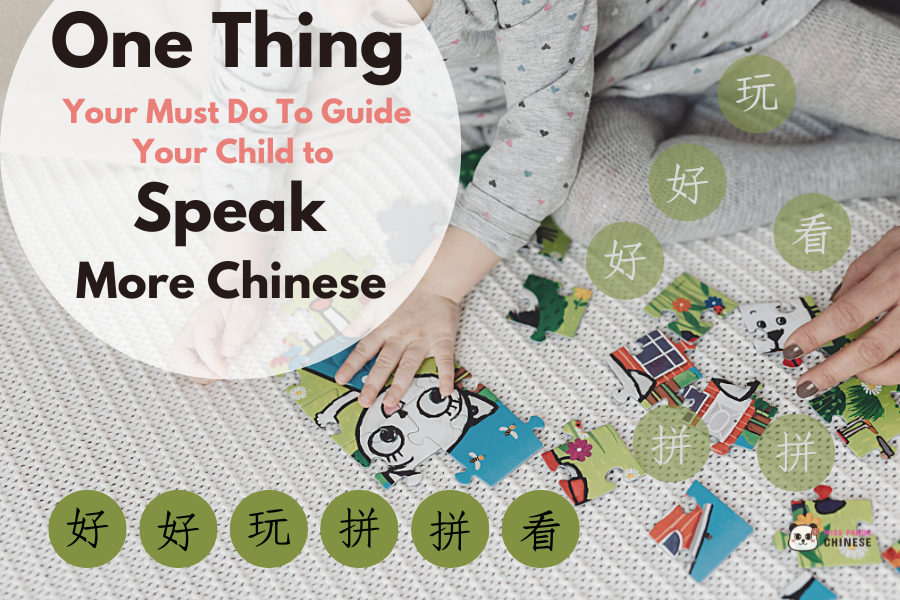Guide kids to speak Chinese – One Thing You Must Do To Guide Your Child to Speak More Chinese
Parents often mention that their children are reluctant to speak Mandarin. To speak more Mandarin, to be exact.
“Why is that?” they ask.
They often continued with, “They go to Chinese classes online / in person…” “My kids use apps…” “They have textbooks…” “We have storybooks…”
ONE QUESTION
My first question to parents is always this one – “Do you feel your child has the words they need to express himself/ herself in the topic you want to engage them in?”
Are the target language resources and materials they have relevant to your child’s daily life? Are the resources cater to your child’s interests and things that are important to them?
When we lack vocabulary or expressions for a subject, we are likely to be more cautious about participating in a topic-centered conversation, even if it is in our native language.
For children, that is even so.
We want to guide kids to use Mandarin naturally. Then we need to feed them the language they need consistently. Providing them the language they can understand in listening and reading. The resources should be a little higher than their current proficiency level. So they are being challenged. And it is manageable for them.
They should not feel overwhelmed.
Children build up their language skills through consistency and repetition. In the process, they experience success.
When they experience success. They will want to repeat the process. Over and over again.
This learning process applies to all skill mastery.
We want the kids to come back for more because they want to.
THREE FOLLOW-UP QUESTIONS
My 3 follow-up questions are:
-
What is your goal?
-
What is your strategy?
-
What are the methods?
ONE STRATEGY
Over the years, as I help my children and students acquire Mandarin the strategy is to keep learning fun.
Keep it simple. NIKE’s strategy is Just Do It.
What’s your strategy?
ONE BIG GOAL
The big goal for me is to guide my kids to reach the language proficiency level so that they can speak Mandarin with their Chinese Grandparents when they visit Taiwan or any Chinese-speaking territories and participate in activities with local children. In the meantime, they can be on their own to function in Mandarin when I am not around.
The day I sent my two kids off on a bus in Taipei and they went to a local summer camp on their own. They reached a milestone. When they finished the camp later that day They decided not to take the bus but to walk back to Grandma and Grandpa’s place surprised me.
They not only came back they came back with their favorite snacks from their favorite Green Onion Pancake (Cōng Yóu Bǐng) vendor and Pineapple bread from the neighborhood bakery. It’s an adventure for them that day.
Grandma Panda was very nervous when she found out her grandchildren were on their way to the summer camp on their own.
My Kids came back and told me about the conversations they had with the street food chef and the staff at the bakery. They did it once on their own and then they did it for the rest of the camp days.
A student’s mother told me her ultimate goal is to see her kids take AP Chinese. That’s a great goal.
What’s your goal?
Write it down. Reflect often.
You can type it in your notes. But, there is magic in writing it down on paper. When you write it down it is real.
Kids grow and we need to equip ourselves with the age-appropriate and proficiency-level comparable resources to meet their needs. Therefore, we need to reflect often and make needed adjustments.
Your ultimate goal is the top-level goal. Under that are your middle-level goals that serve to reach the top-level goal. And, under the middle-level goals are your low-level goals that serve to reach the middle-level goals. This concept is from Dr. Angela Duckworthy’s Hierarchy of Goals and I’ve found it is practical for parents to apply to raise bilingual kids.
Parents are busy with work and family. Simplicity means less stress. That’s where the low-level goals or I call them the tiny goals that you can achieve each day or each week.
How do you do that?
The best way to learn is to do!
Studies have shown
Active learning helps students learn better by engaging them physically
50 Methods and Activities to Engage Kids in Active Chinese Acquisition
1. Listen to nursery rhymes in Mandarin Chinese | input
2. Listen to children’s songs in Chinese | input
3. Listen to word books in Chinese | input
4. Listen to simple bedtime stories in Chinese | input
5. Listen to children’s short form/ board book stories in Chinese | input
6. Listen to story podcasts that perform stories in Chinese | input
7. Listen to children’s books/ book series in Chinese | input
8. Put up labels for household items in Chinese | input
9. Dedicate a Chinese Word Wall in a visible and heavy traffic area at home | input
10. Start a Chinese Home Library. Start small with a basket dedicated to books in Chinese or bilingual books in Chinese and English | input
11. Read word books in Chinese, if you speak and read Chinese. Read word books in Chinese and English, if you are just starting. | input
12. Read Wordless books. | input
13. Read board books in Chinese. | input
14. Read picture books in Chinese. | input
15. Read early reader books in Chinese. | input
16. Read chapter books in Chinese. | input
17. Read leveled readers in Chinese. | input
18. Look at family photo books and identify people, places, and occasions in Chinese. | input-output
19. Look at pictures and graphics in children’s magazines and identify items in Chinese. | input-output
20. Look at travel, cooking, and outdoor magazines and identify items and activities in Chinese. | input-output
21. Take a walk and play the I SPY game in Chinese. (novice level – intermediate level)
22. Visit a petting Zoo. Observation, petting, and touching are great ways to engage kids in Chinese. (novice level – intermediate level)
23. Visit an Aquarium. Observation, asking questions with possible and silly answers. (novice level – intermediate level)
24. Visit a museum. Tour, take pictures and focus on the interest of your child. (novice level – intermediate level)
25. Go to a park. (novice level – intermediate level)
26. Go to a Chinese restaurant. (novice level – intermediate level)
27. Participate in a Chinese cultural event in Chinatown. (novice level – intermediate level)
28. Do craft projects in Chinese. | project-based
29. Do science projects in Chinese.| project-based
30. Bake cookies in Chinese. | project-based
31. Bake cupcakes in Chinese. | project-based
32. Make simple soups in Chinese. | project-based
33. Cut fruits in Chinese.| project-based
35. Make sandwiches in Chinese.| project-based
36. Talk about daily routine in Chinese. ie. how to brush teeth, wash face, take a shower, …etc. | everyday life skill
37. Look, touch, and say the names of items, objects, and toys… in Chinese. | early literacy
38. Ask questions in Chinese and provide possible answers in Chinese. | language development
39. Use activity books, play books, word cards. | literacy development
40. Use story cubes to tell funny stories in Chinese. | literacy, logic, sequence skills
41. Use number cubes to play simple math games in Chinese. | numbers, math skills
42. Use dice set to play counting games in Chinese. | numbers, sequence, logic skills
43. Play board games in Chinese. | language, strategic skills
45. Wash dishes in Chinese. | life skill
46. Water the garden in Chinese. | life skill
47. Turn your pet (or stuffed animal) into a Chinese learning partner and teach your pet Chinese with your kid. |language
48. Schedule consistent video calls with your child’s Chinese-speaking relatives to facilitate conversation in Chinese. (novice to advanced level) | language development, social skill
49. Attend a reading club to make reading in Chinese an exciting event with peers. | language develope, social skill
50. participate in an activity-based group to make speaking Chinese a part of the fun.| language develope, social skill
51. Join a Chinese-speaking circle and community for parents and kids to grow and advance together with an experienced teacher/guide. | language development, social skill
52. Immerse your child in Chinese with travel. Experience Chinese and Chinese culture in person can have a very powerful impact on your child. Plan it well and enjoy the trip. | language, culture, travel, planning, life skill, social skill
What About Bilingual Resources?
Using bilingual books and bilingual resources at the beginning stage is totally fine. For parents who are learning or brushing up on Chinese, the Pinyin and English support is a tool, an aide in the process. You will gradually fade out English as your child advance.
Learners of all ages will need to understand what is said to them in Chinese, the target language. Children will also need to understand what is read to them in Chinese. When learners have comprehensible input they acquire a language with joy and confidence. They will want to speak Mandarin. They will feel safe engaging in Mandarin.
Ultimately, they embrace the challenge that comes with the advancement in the Chinese language. These children have the growth mindset to keep going and move forward to reach one milestone after another. What I’ve shared here is not a theory. This is what I have seen over and over again in my 20+ teaching career working with children, parents, and schools on four continents.
Resource Idea
Sample Lesson Plan For Halloween
Here are the resources to add words, expressions, and sentences to your teaching repertoire. More importantly, kids will have fun playing and learning at the same time.
🎬 STORY: 🎃 Five Little Pumpkins in Chinese and English | Input focused
🎬 STORY: 🕸 Five Little Spiders in Chinese and English | Input focused
✄ PLAY: 🧩 Puzzle printables | Input & Output – Hands-on activity
✏️ BINGO: 🍁 Can you find all the items in your neighborhood? | Input & Output – Physical activity
🎩 LESSON PLAN: 🏛 Halloween Literacy pack | Input + Output – Literacy

• guide kids to speak Chinese •
